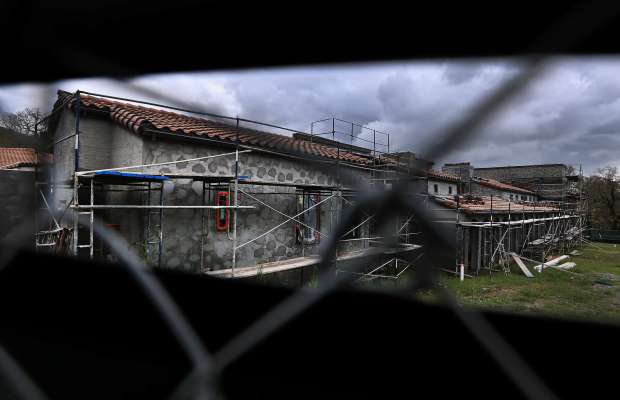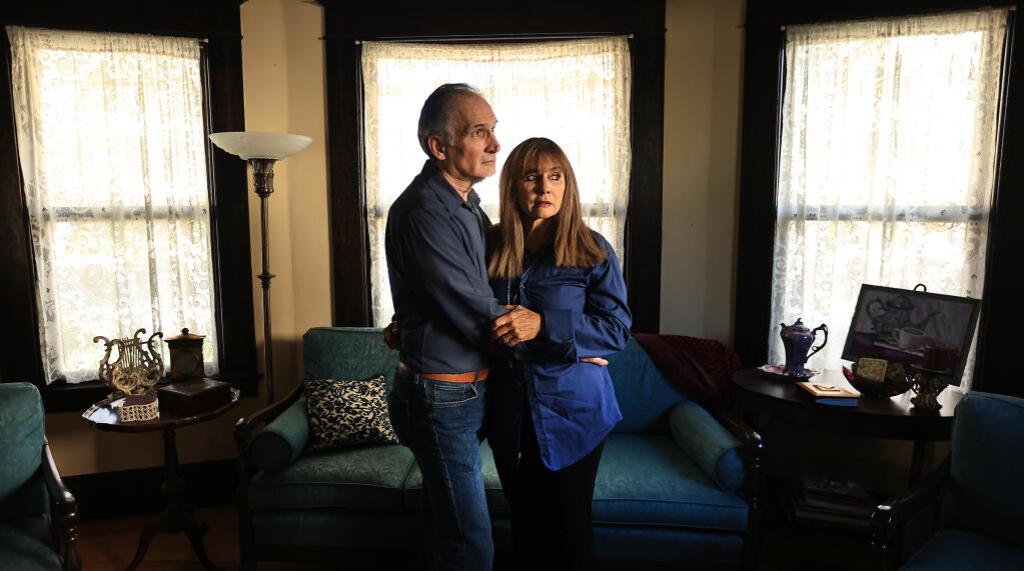Lawyers in the bankruptcy cases tied to indicted Sonoma real estate mogul Ken Mattson were especially busy in mid-October, filing a flurry of court documents that lay out a roadmap for compensating the many people left owed by Mattson’s troubled investment businesses — including the mom-and-pop investors who financed more than 200 property acquisitions and now find their financial futures in jeopardy.
The attorneys also announced a settlement agreement with the largest creditor, Socotra Capital, a private lender that financed the majority of property purchases made by Mattson as he guided investments for two companies he co-owned, LeFever Mattson Inc. and KS Mattson Partners. Both are now in bankruptcy.
And attorneys also filed a 157-page investigative report that sheds additional light on the ways Mattson moved and shielded money among various corporate entities, allegedly for his personal enrichment.
The plan of liquidation and the Socotra settlement both were presented as efforts to save time and money in the bankruptcy proceedings, avoid further litigation and reduce risk for the hundreds of investors who placed their retirement savings in Mattson’s hands.
All of the documents were filed jointly on Oct. 15 by attorneys representing LeFever Mattson, KS Mattson Partners and the committee of unsecured creditors that advocates on behalf of investors in the now-consolidated bankruptcy cases.
Kent Porter / The Press Democrat
Stacy and Ken Mattson walk to their vehicle March 15, 2025 at Depot Park in Sonoma after being confronted by members of Wake Up Sonoma, a grassroots advocacy group. (Kent Porter / The Press Democrat)

Kent Porter / The Press Democrat
Houses under construction at the corner of Hwy. 12 and Moon Mountain Road near Sonoma. The property, until recently owned by Ken Mattson’s company, has been under construction for several years. (Kent Porter / The Press Democrat)

Mattson family home surveillance footage seized by FBI and included in court documents
Real estate investor Ken Mattson moves through his home on Castle Road outside Sonoma in May 2024. Federal prosecutors accuse Mattson and family members of purging evidence at that time, two days before the FBI raided the house. (Mattson family home surveillance footage seized by FBI and included in court documents)
Show Caption
Kent Porter / The Press Democrat
1 of 3
Stacy and Ken Mattson walk to their vehicle March 15, 2025 at Depot Park in Sonoma after being confronted by members of Wake Up Sonoma, a grassroots advocacy group. (Kent Porter / The Press Democrat)
The parties who wrote the plan are proposing a global settlement that treats all investors the same, whether or not Mattson properly recorded the interests they ostensibly paid for. It’s a “single-pot” plan that pools and consolidates all of the bankrupt companies’ assets and liabilities for eventual distribution — a framework also known as substantive consolidation.
The utilitarian approach is a necessity, its architects contend, due to the abysmal state of Ken Mattson’s bookkeeping.
He and his childhood friend Tim LeFever were equal partners in LeFever Mattson while Mattson and his wife, Stacy, had equal ownership of KS Mattson Partners. But as detailed in the investigative report, Ken Mattson kept records for both companies. And the files were lacking.
When the court appointed a corporate governance expert, Robbin Itkin, to steer KS Mattson Partners in bankruptcy, she couldn’t locate a list of properties owned by the company, or basic cash flow statements. By that time, according to the U.S. attorneys who have charged Mattson with wire fraud, money laundering and obstruction of justice, he had deleted 30,000 files from his laptop and a cloud file-sharing service.
Mattson, who has pleaded not guilty, disputed those accusations in court.
Itkin negotiated access to documents seized by the FBI in a May 2024 raid of Mattson’s house on Castle Road near Sonoma and later shared during the criminal discovery process. “To date, however, Mattson has produced only 90 documents,” according to the new investigative report.
Filling in the gaps, the plan organizers wrote, could require a forensic accounting dive costing more than $35 million, and might ultimately be impossible. Itkin did obtain bank records directly from BMO and First Bank, the institutions that hosted Mattson’s accounts. LeFever Mattson opened an account at Bank of the West, which was later acquired by BMO, more than 20 years ago.
But BMO retains records for only seven years. Itkin and the creditors committee began seeking information in 2024, so 2017 has become a key cutoff day under the plan. That is just two years after Mattson began a surge of Sonoma real estate acquisitions now figuring in both his bankruptcy cases and the criminal proceedings, where prosecutors have accused him of running a “classic Ponzi scheme.”
As proposed, all the money invested in Mattson’s many real estate ventures over the years would be eligible for full compensation, minus any distributions investors received between 2017 and 2024; call those Class 1 claims. If funds should remain after those debts are paid off, the deducted distributions will then become eligible in a second pool of assets — Class 2 claims.
To use an example cited in the plan summary, say Investor A advanced $100,000 to LeFever Mattson on Jan. 1, 2015, then received the promised distributions of 6% a year — or $500 a month — until September 2024. Those monthly distributions would add up to $42,000. Subtract that figure from the original $100,000, and Investor A would be fully eligible for compensation of $58,000. If money remains after that is paid in full, the deducted $42,000 would become eligible for repayment.
30 cents on the dollar
In reality, the prospect of people being fully compensated for their LeFever Mattson investments is looking increasingly dim.
A liquidation analysis included in a court-filed disclosure statement estimates that after attorneys, accountants and real estate experts are paid for their work in the bankruptcy, available assets will be valued at somewhere between $33 million and $67 million. Class 1 claims, meanwhile, total around $231 million. The analysis estimates investors are likely to get somewhere between 20%-40% of their money back.
If the pool of funds is smaller than what is owed, investors will be compensated proportionately for their investments. A couple who put in $2 million will get 10 times as much as a couple who put in $200,000.
Investors will get a chance to vote on the plan. A majority of those casting votes, and at least two-thirds of the investment dollars represented by those ballots, would have to vote “yes.”
To maximize the compensation pool, bankruptcy administrators continue to analyze and sell off real estate belonging to LeFever Mattson and KS Mattson Partners. As of Monday, 34 of those properties had been sold (including nine in Sonoma), with another 12 sales pending (four in Sonoma). Dozens more properties are on the market.
In a separate action last week, the creditors committee and the bankruptcy attorneys announced a settlement with Socotra Capital, the Sacramento-based “hard money” lender that wrote loans for 77 LeFever Mattson or KS Mattson Partners properties. Those loans currently total around $94 million in outstanding principal and more than $37 million in interest and fees, making Socotra the bankrupt companies’ largest creditor.
The settlement deal shows that the same parties that wrote the liquidation plan also investigated Socotra and, before two days of mediation, intended to sue the lender, alleging “fraudulent transfer.”
Socotra “vigorously denied any culpability on both legal or factual grounds” and signaled it would contest both the proposed terms of the liquidation plan and a potential Ponzi scheme finding — a court ruling that might have curtailed Socotra’s ability to recoup money owed for mortgage interest. Costs for litigation against Socotra were estimated at more than $15 million. The two sides opted to settle.
Under terms of the agreement, Socotra will waive the $37 million it’s owed in accumulated interest and fees, along with current and future mortgage payments on properties held by LeFever Mattson or KS Mattson Partners. Socotra gains the right to foreclose on 22 of the properties — all but one of them in Sonoma.
The other 55 will be sold out of bankruptcy. Socotra Capitol will receive 75% of the proceeds on those sales, and the trust set up for repaying investors will get 25%, until the balance is repaid. The two sides will receive 50% each on any profit beyond that.
“Socotra had no knowledge or involvement in Mattson’s alleged wrongdoing, and acted appropriately and in accordance with the law at all times,” the company wrote to The Press Democrat. “This agreement enables Socotra to move forward and focus on real estate lending around the country, while also recovering the capital from loans related to this matter.”
Finally, the lengthy investigative report added new layers of detail to the unfolding Mattson saga. Kevin Katari, chair of the creditors committee, said the report “is tough reading for those who entrusted their life savings to LeFever Mattson. The scope and complexity of the frauds have made this extraordinarily expensive to untangle.”
Leaky roofs, vermin, black mold
In conducting the investigation, committee members issued more than 30 subpoenas and collected more than 1.2 million documents.
Among the findings alleged in the report:
• Starting in 2006, LeFever Mattson frequently shifted funds from subsidiary entities with extra reserves to those that were falling short. From 2017 to 2024, there were close to 6,000 of these intra-company transactions, with a gross dollar amount of $635 million. And much of it was done by Mattson “without any formal documentation,” according to the report. Among intra-company transactions investigators located through bank records, the payables and receivables don’t balance out.
• Mattson created what investigators say were fraudulent K-1 tax forms for investors to whom he sold nonexistent real estate interests. On the forms, he is alleged to have frequently made up names that mimicked real LeFever Mattson entities. For example, Country Oaks I LP became Country Oaks LP, River Birch LP became River Birch Investments LP and River Tree Partners LP became Rivertree LP.
• The Press Democrat has previously reported on the “1059 account,” a Bank of the West (later BMO) account through which Mattson allegedly moved more than $100 million of investor money. But the report introduces another BMO pot, the “1380 account.” Mattson consistently deposited investor receipts into 1059, then transferred them to 1380; when he needed to pay investors, he’d transfer the money back to 1059 first.
More than $91 million moved from one account to another between 2017-2024. Mattson also used the 1380 account as a personal “slush fund,” the report alleges, making $510,000 in payments to a Macy’s credit card between 2017 and 2022, and other fees to Planet Fitness, Best Buy, Kia and Primerica, a multi-level marketing company that provides personal insurance services.
• Since at least the early 2000s, the profits generated by the Mattson-related real estate portfolio were unable to sustain the monthly distributions needed to meet the promised 6% annual return. So Mattson would tap into a property’s reserve funds — money typically used for upkeep and improvements. “As a result,” the report says, “many of the Properties suffer from maintenance and upkeep issues,” a pattern familiar to many in the legion of Sonoma residents who emerged as Mattson critics. The report cites issues like leaking roofs, rotted and unsafe staircases, vermin infestations and black mold.
Charles Novack, the bankruptcy judge, will hold a hearing to review the liquidation plan Nov. 19. Ballots will go out by Dec. 3, and votes must be cast by Jan. 7. That’s also the deadline for investors to object to their proposed claim amounts. The plan confirmation hearing is tentatively scheduled for Feb. 4.
Even if the process moves forward as proposed, that won’t necessarily signal the end of the wrangling.
The creditors committee has received court standing to pursue legal action against Mattson, Tim LeFever and Hanson Bridgett, the law firm that formerly represented LeFever Mattson. And a disclosure statement released alongside the liquidation plan identifies a much wider “Target List” of entities who could potentially be pursued by whoever is appointed to oversee the trust.
The list includes Stacy Mattson; Amy LeFever, Tim’s wife; lawyers representing Ken Mattson, including Randy Sue Pollock and Fennemore Law; real estate brokers who helped Mattson acquire properties; IRA custodians such as Madison Trust and Pacific Premier Trust; the Capitol Resource Institute, a right-leaning nonprofit that at one time counted Tim LeFever as chairman of the board; and churches including Sonoma Collective in Sonoma, First Covenant in Oakland and Creekside Community in San Leandro.
Tim LeFever, who publicly accused Mattson of fraud in May 2024, documenting his allegations in letters to the U.S. Securities and Exchange Commission and the Department of Justice, has not been arrested or charged. But he and Mattson and their defunct partnership are co-defendants in at least seven lawsuits, all of which have been paused by the bankruptcy.
You can reach Phil Barber at 707-521-5263 or phil.barber@pressdemocrat.com. On X (Twitter) @Skinny_Post.

